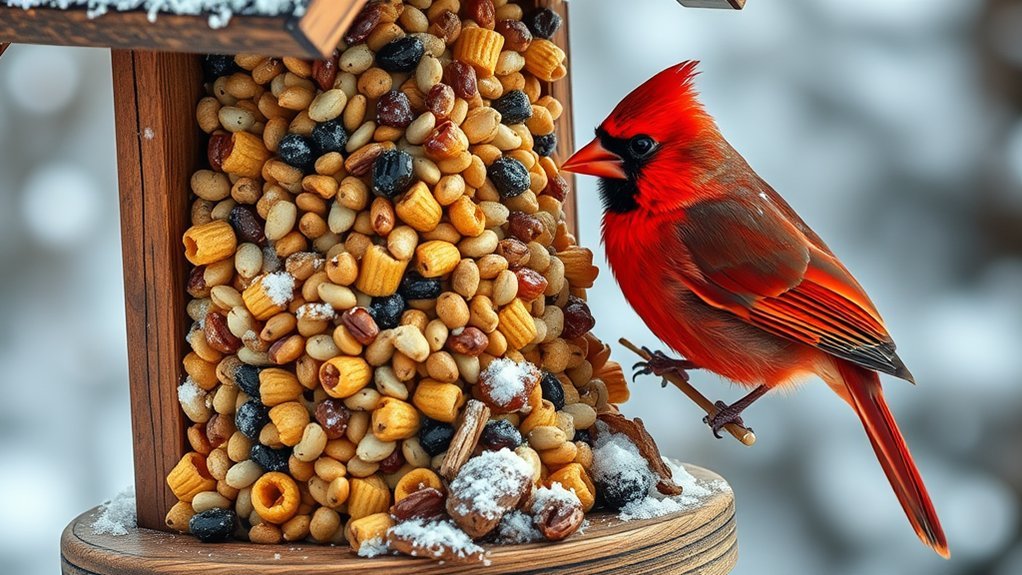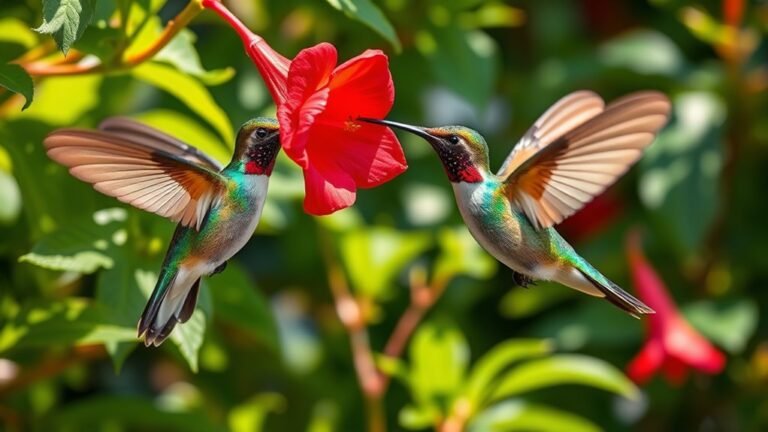Best Winter Food for Birds: Seeds, Suet, and More
Feeding birds in winter is vital for their survival. They need high-energy foods to stay warm. Seeds like black oil sunflower seeds, suet, fruits, and nuts attract many bird species. Knowing how to select and care for these food sources will help you create a welcoming winter environment for birds. Let's look at the food birds prefer in winter and their nutritional needs.
Key Takeaways
- Offer high-energy sunflower seeds, especially black oil sunflower seeds. These seeds provide essential fats and proteins for birds in winter.
- Include suet in your feeding routine. It gives vital calories that help birds maintain body heat in cold weather.
- Add millet varieties to attract ground feeders. This variety ensures a diverse seed selection for different bird species.
- Provide sliced apples and berries to draw in fruit-loving birds such as robins, woodpeckers, thrushes, and finches.
- Clean and maintain your feeders regularly. This keeps them free from contamination and supports a healthy feeding environment for winter birds.
Understanding the Nutritional Needs of Winter Birds
Understanding the nutritional needs of winter birds is vital for their survival during cold months.
In winter, birds need more energy to stay warm and active. They require higher calorie intake to support their increased metabolism. Cold weather makes it important for birds to find food rich in fats, proteins, and carbohydrates.
Birds often fluff their feathers for insulation, which also requires energy. To help them thrive, provide high-energy foods. Suet is an excellent choice due to its high fat content.
Seeds rich in oil are also beneficial. By offering these foods, you can improve the chances of birds surviving the winter. Your feeding efforts can make a significant difference in their well-being.
The Best Seeds for Winter Feeding
To help birds survive winter, offer a variety of seeds. Sunflower seeds are a great choice. They provide high fat and protein, which are important for energy in cold weather.
Black oil sunflower seeds, with their thin shells and high oil content, attract many bird species. Additionally, millet varieties like proso millet and foxtail millet are effective options.
These smaller seeds appeal to ground feeders such as sparrows and juncos. By including sunflower seeds and millet in your winter feeding plan, you create a nourishing environment for birds as they endure the cold.
Suet: A High-Energy Food for Cold Weather
Suet is an excellent source of high-energy nutrition for birds during the cold winter months.
Its high fat content provides essential calories that help them maintain body heat and energy levels.
To make the most of this nutritious food, it's vital to understand the different types of suet and how to properly use suet feeders to attract a variety of bird species.
Nutritional Benefits of Suet
Suet is an important food for birds during winter. It gives them high energy, which is essential for survival in cold weather. Here are the main benefits of suet:
- High Fat Content: Suet provides a lot of fat, which gives birds the energy needed to stay warm.
- Vitamins and Minerals: Many types of suet have added vitamins and minerals that support bird health.
- Balanced Nutrition: Suet often includes seeds and fruits, providing a range of nutrients.
- Attracts Different Birds: Many species are drawn to suet, promoting a diverse bird population in your backyard.
Incorporating suet into your birdfeeding will help sustain birds and create a lively environment.
It's an easy way to support wildlife in your area.
Types of Suet Feeders
To attract birds in winter, it's important to choose the right suet feeder. Different types of suet are available, including traditional suet cakes, nuggets, and pellets. Each type offers unique benefits based on the bird species you want to draw in.
Feeder materials vary as well. Wire cages provide easy access for clinging birds, such as woodpeckers. Plastic feeders may include baffles to keep the suet dry and intact.
Selecting the right combination of suet type and feeder design can help you attract a wide variety of birds during the colder months. Enjoy watching the different species that come to visit!
Fruits and Nuts: Attracting a Variety of Species
Many birds change their diets in winter. You can attract different species to your yard by offering fruits and nuts. Here are some easy suggestions:
- Apples: Cut them into slices to attract robins and woodpeckers.
- Berries: Provide blueberries or holly berries for thrushes and finches.
- Peanuts: Serve unsalted shelled peanuts to bring in jays and chickadees.
- Walnuts: Use crushed or whole walnuts to draw nuthatches and sparrows.
These simple options will help you create an inviting environment for various birds in your area.
Enjoy watching them visit your yard!
DIY Bird Feed Mixes for Winter
Making your own bird feed mixes for winter can attract more bird species to your yard.
Start with seeds like black oil sunflower seeds and safflower. These seeds appeal to many birds.
Next, add ingredients like chopped nuts for protein and dried fruits for energy. You can also include rendered animal fat to make suet cakes that provide extra energy.
Combine these ingredients and place them in homemade bird feeders for easy access.
Try different mixtures to see which your birds like best.
This process will improve their winter diet and bring a greater variety of birds to your outdoor space.
Enjoy watching the wildlife that visits!
Tips for Maintaining Your Winter Bird Feeder
To attract and support winter birds effectively, you need to maintain your feeder with regular cleaning practices.
Selecting the best seeds and the right types of suet is also essential for providing a nutritionally balanced diet.
Regular Cleaning Practices
Keeping your bird feeder clean is important, especially in winter when birds depend on you for food.
Here are four simple cleaning steps:
- Clean Regularly: Clean your feeder at least once a week. Do this more often if you see leftover food or bird droppings.
- Use the Right Cleaning Solution: Wash the feeder with hot, soapy water. You can also use a diluted bleach solution, mixing one part bleach with nine parts water to disinfect it.
- Choose the Right Spot: Place your feeder at least 10 feet away from birdbaths and trees. This helps reduce the risk of contamination.
- Let It Dry: After cleaning, let the feeder dry completely before putting food back in. This prevents mold from forming.
By following these steps, you help keep the birds healthy and happy.
Enjoy watching them come to your clean feeder!
Optimal Seed Selection
Choosing the right seeds is key for your winter bird feeder. Different bird species have unique preferences based on their nutritional needs. Sunflower seeds attract many birds like cardinals and finches because of their high fat content. Goldfinches prefer Nyjer seeds, while sparrows and juncos enjoy millet.
When selecting seeds, consider the feeder type. Tube feeders work well for smaller seeds, while platform feeders are better for larger seeds.
Keep your feeder clean and filled with the right seeds to attract a variety of birds.
Try rotating different seed blends to discover which ones attract the birds in your area. This strategy can enhance your winter birdwatching experience. Enjoy the sights and sounds of the birds as they visit your feeder!
Best Suet Types
Suet is a high-energy food that attracts many birds in winter. Here are the best types of suet to consider:
- Beef tallow: This type has a rich fat content that draws woodpeckers and nuthatches.
- Rendered suet: This is solidified animal fat, great for homemade suet recipes.
- Peanut butter suet: This type is high in protein and attracts chickadees and blue jays.
- Fruit and nut mixes: Combining dried fruits and seeds provides a nutritious homemade suet that can attract various birds.
Keep your feeders clean and stocked with fresh suet.
This ensures birds receive the energy they need during the cold winter months.
Enjoy watching the birds that come to your feeder!
Frequently Asked Questions
Can I Use Table Scraps to Feed Birds in Winter?
You can feed birds table scraps in winter. Make sure the scraps are good for them. Do not give birds salt, processed foods, or sugar. Instead, offer fruits, vegetables, or unsalted nuts. These options provide safe and nutritious snacks for our feathered friends. Enjoy watching birds enjoy the snacks you provide!
How Often Should I Refill My Bird Feeder?
You should refill your bird feeder every few days. Regularly providing food ensures birds keep visiting. This helps maintain a clean feeding area and prevents food spoilage. Establishing a consistent feeding schedule benefits both you and the birds. Enjoy watching your feathered friends come back for their meals!
What Kind of Bird Feeders Are Best for Winter?
For winter, use tube, platform, or suet feeders. Tube feeders keep seeds dry. Platform feeders attract birds that feed on the ground. Place feeders near bushes or trees. This offers birds safety from harsh weather. Make it easy for them to find food and shelter.
Do Different Bird Species Prefer Specific Feeding Times?
Different bird species prefer specific feeding times, influenced by their habits and seasons. Most birds feed in the morning and late afternoon. These times help them maximize food intake, which is essential for their survival. Understanding these feeding patterns can help bird watchers know when to observe different species.
How Can I Keep My Bird Feeder From Freezing?
To prevent your bird feeder from freezing, use heaters or choose insulated designs. Heated birdhouses can also add warmth. This will ensure birds have access to food during cold weather. Keep your bird feeding simple and effective for the benefit of our feathered friends.

Kashvi is a passionate bird enthusiast and nature lover who has been fascinated by the world of birds for years. With a keen eye for detail and a love for learning, Kashvi is dedicated to sharing her knowledge and insights with fellow bird enthusiasts on Avian Enthusiasts. Through her engaging and informative articles, Kashvi aims to inspire others to join her in exploring the fascinating world of birds and to promote a deeper appreciation for these incredible creatures.







